SABA PERMADYN 19-200-5298-U8, 5
ohms and tweeter SABA 1670-DU-20 (or -15), 5 ohms
| These SABA
greencones have true cult status in
central parts of Europe and they're not hard to
find. They must have been made in 6 or even 7
digit numbers during all of the Fifties and well
into the Sixties by SABA, Germany. Other (German)
companies made similar products, but the SABA
greencones were what Philips 9710 was to Holland,
Supravox 215RTF to France and NNNN (?) for the
Britts. What is the British equivalent of these
8" extended range drivers? I guess we have
to look for Goodmans and Wharfedale speakers to
find out. In Denmark we had Peerless, e.g.
Orchestra, although I recall my parents' radio
actually had a 6" Goodmans unit. The
SABA greencone has a one-piece molded
cone including a non-coated corrugated surround.
A rugged small dust cap is glued to the cone to
protect the voice coil and a light-weight stamped
metal chassis holds it all together. A tiny
alnico magnet and stamped, cost-efficient metal
parts provides the unit a whopping 94-95 dB/2.8V
sensitivity. Despite meant for valve amps, Re is
set for 5 ohms, but no anaemic 2A3 SET amp will
suffer serious trouble from being connected to
these speakers - or at least so I thought...
Forget
about traditional hifi. Greencones will
never make much below ~60 Hz and the tiny voice
coil will never generate serious amounts of back
EMF, nor require serious amounts of current.
Having Fs = 75 Hz we need big cabs to generate
something below 100 Hz and the
"resonanz" box is most likely the best
thing we can do - or use them as a dedicated
midrange driver in open baffle systems. The use
of resonant boxes is controversial. I know there
are people who believe in speakers being
"instruments" and I've even had a mail
stating a "Steinway isn't made from MDF,
right?" Well, I won't argue that these
people got it all wrong, because people can do
whatever they want and if quality time is a
resonant box, who am I to say they're wrong.
Don't be surprised if you some day find a thin
plywood box for my greencones on this page.
What
we're after here is the midrange and
minimum phase shift in lower treble range.
Generally these greencones display smooth
midrange except for the phase shift around 900
Hz, a phase shift much more tolerable than the
serious phase shift around 2.5 kHz found in
Lowther drivers. Next these drivers have a smooth
upper roll-off profile. I wish every midbass
driver had a roll-off like this. It makes
crossover work so much easier, and not having any
serious trouble in all of the important treble
range certainly does please the ear. Only the Vifa
C20WH can do something similar,
although not as extended as the greencones.
What is a general limitation of greencones - and
the few other drivers of similar construction -
is limited power handling. As long as we don't
play too loud, things go well. Cranking up
volume, things fall apart, cones break up and we
get the "midrange shout", i.e. serious
distortion. Using the unit as an extended range
driver also calls for beaming of upper mid and
loer treble with subsequent loss of detail and
perceived level of transparency.
Last,
but not least, we're into serious
nostalgia when dealing with greencones. We may
love the "good old days" and nostalgia
is definitely part of the fun, but before rushing
to German eBay, we must think about what these
drivers can offer - and seriously think about
what they cannot. The Supravox 215RTF is a much
better driver - but cannot be found for 50
EUR/pair.
|
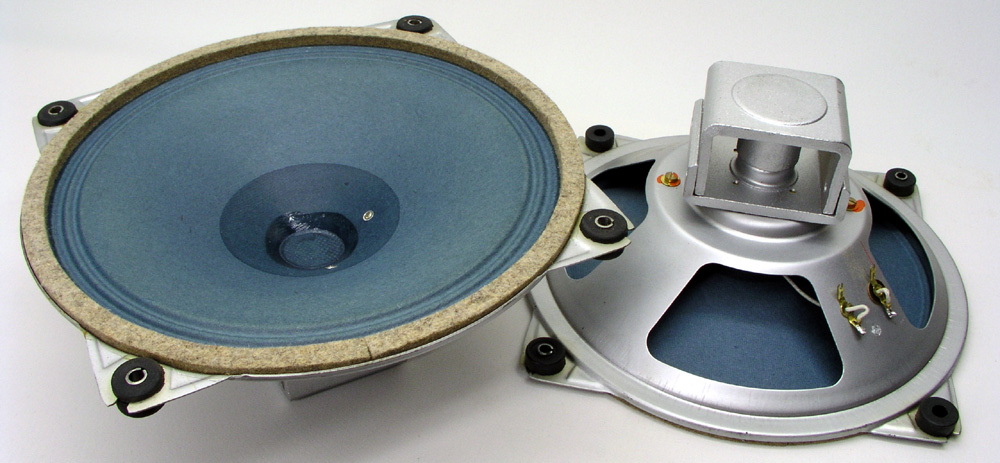
Links to greencone sites:
http://www.lebong.de/greencone/index.htm
http://www.butterfly-reso-speaker.de/butterfly-en.htm
http://home.arcor.de/pfaue/klangkue/gruenwunder/galerie/galerie.htm
http://www.lampizator.eu/ go to 26 speaker
projects
http://home.arcor.de/pfaue/klangkue/gruenwunder/gruenwunder.htm
http://www.german-vintage-loudspeakers.com/
http://www.klangfuzzi.com/rep_profi_Rullit_SabaRlA306.php
http://www.visaton.de/vb/showthread.php?s=&threadid=7449&perpage=15&pagenumber=2
http://www.lencoheaven.net/forum/index.php?topic=1738.0
The drivers
(back to top)
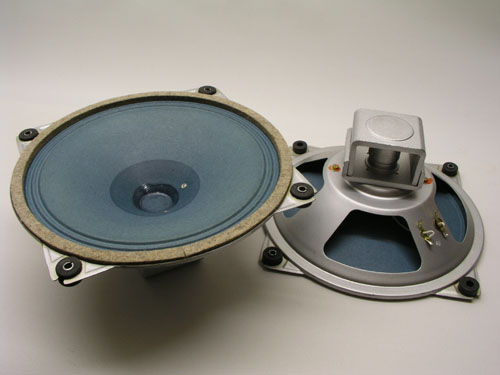 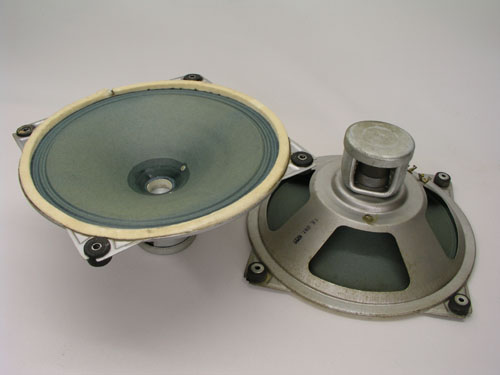
Left:
SABA PERMADYN 19-200-5298-U8, 5 ohms. Same unit ID
regardless of magnet system.
One of the units to the right was damaged due to poor
packing, but could be restored to have the voice coil
moving again - and a candidate for experiments.
The dust cap leaves a small space between cone and pole
piece acting as a pneumatic break, and I wouldn't be
surprised if this was intentional. It
might prevent the cone from excessive movement - and
remember - these drivers were meant for being placed in a
"radio" = an open baffle, not having the
damping
properties of a closed or vented box. As can be seen from
the impedance measurements below, removing the dust cap
has a significant impact on Qm.
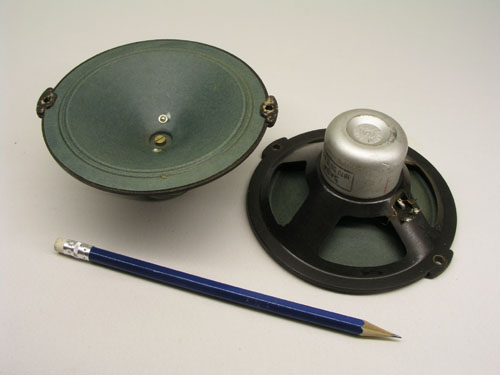 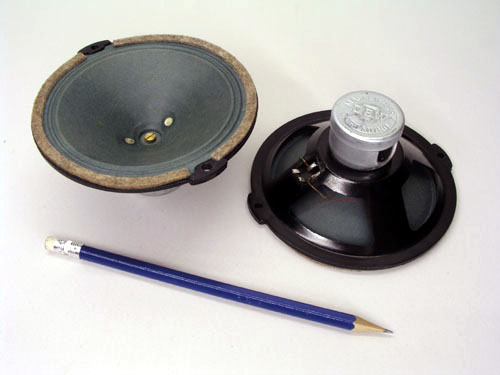
Left:
Tweeter SABA 1670-DU-20, 5 ohms. Right: SABA 1670-DU-15,
5 ohms (both bakelite chassis).
These tweeters are some strange creatures having the dust
cap fixed to pole piece by a brass screw, thus
a rugged mechanical high-pass filter. The impact on
frequency response from this is a broad peak centered
around
12-14 kHz, 15 dB above basic level - and some 10 dB above
the average response from the 8" driver.
Those who choose to run their tweeter from a single cap
alone, usually 2.2 uF, certainly get some upper treble
level!
Greencones cabs found on the web
- found from links above.
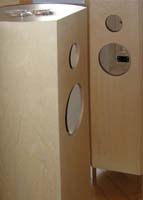 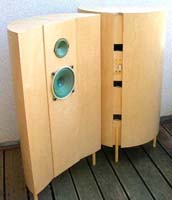 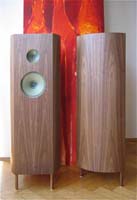 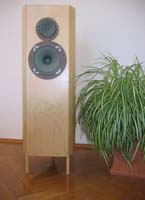 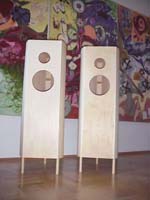 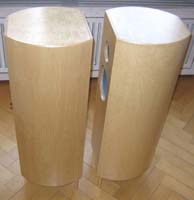
Resonanz
boxen. Enclosures made from thin plywood with minimum
bracing and damping.
SABA
PERMADYN Tweeter 1670-DU-20 (or -15) measurements
(back to
top)
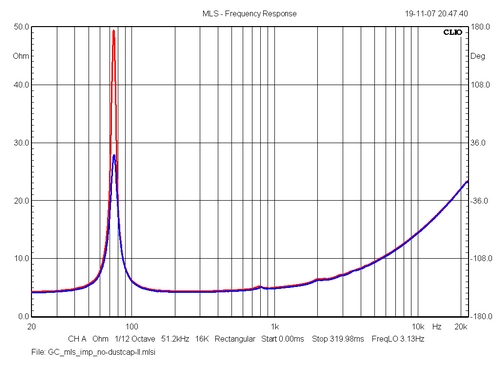 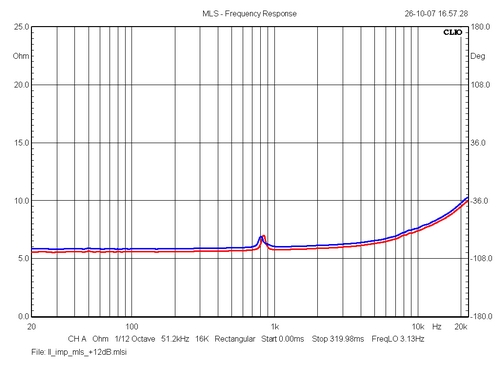
Left:
Impedance of 19-200-5298-U8 driver w/wo dust cap (red =
wo). Right: Impedance of two 1670-DU-20 (or -15) tweeter
units.
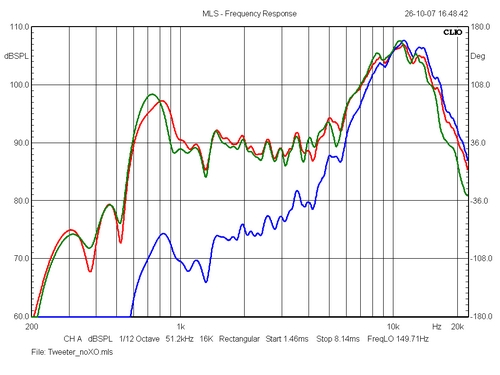
The
tweeter: SPL/2.8V, 1 meter. Red/green = two units, blue =
4.7 uF in series with tweeter.
SABA
PERMADYN 19-200-5298-U8 measurements on
IEC baffle
In total I have four Permadyn
19-200-5298-U8 drivers, two in mint condition and two
so-and-so, where one was damaged
during transport and had a ripped cone suspension, which
was repaired with some flexible glue.
Mint condition drivers = unit I and II
So-and-so condition: Unit III and IV. Both have had the
dust cap removed.
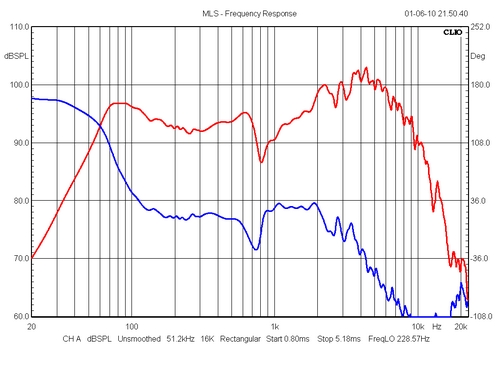 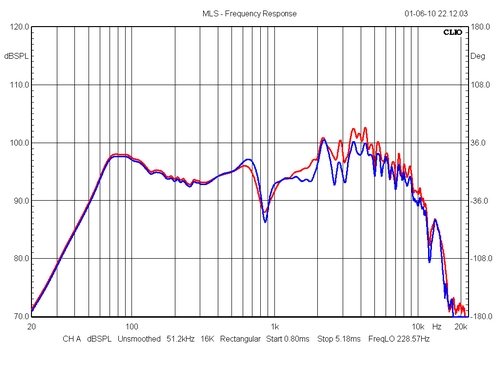
Left:
Unit I, SPL measured on IEC baffle at o.25 m distance.
Input normalised for 2.8V/1 meter. Blue = minimum phase.
Measurements merged at 300 Hz with nearfield measurement.
Right: Same driver front mounted and rear mounted (15 mm
baffle). Blue = rear mounted.
The Permadyn drivers were made to be rear mounted, but it
certainly doesn't improve measured performance having a
short "tube" in front of the driver.
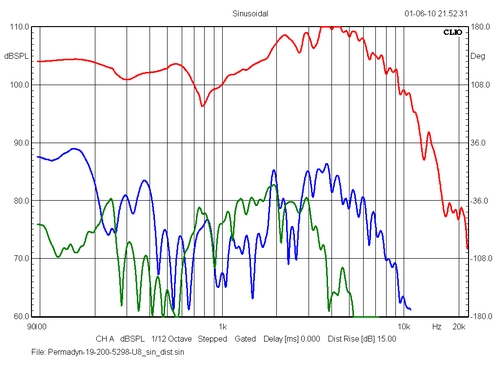 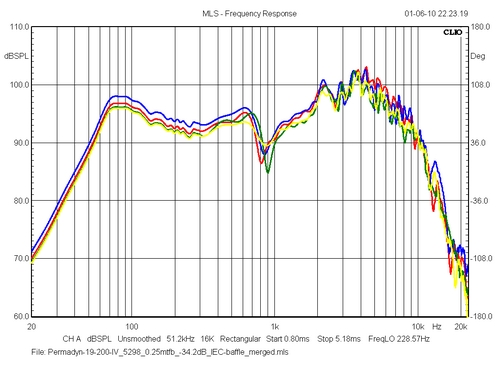
Left:
Distortion measured on IEC baffle @ 0.25 meter distance.
Input equivalent to ~90 dB/1 meter.
Blue = 2nd, green = 3rd. Equalising the 2-8 kHz range
will certainly provide a nice distortion profile.
Right: All four drivers for comparison.
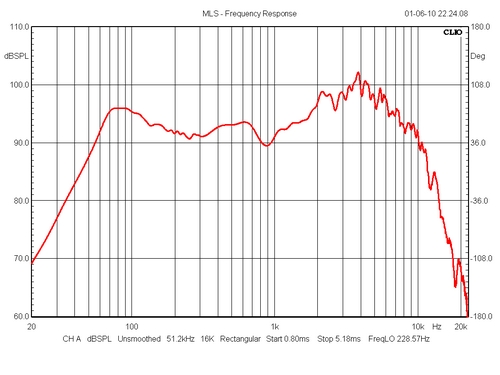 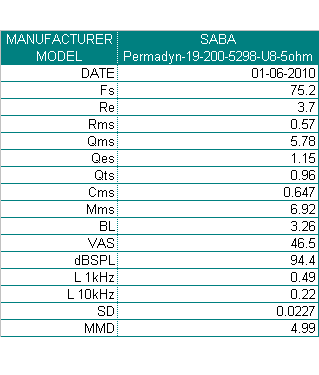
Left:
Driver IV (damaged surround) is interesting as the
currogated paper surround (integrated part of cone) is
quite soft and this seems to have an
impact on the resonance at 900 Hz. This points to some
experiments with a very light coating of the surround.
Right: TS data for unit I. Qt = 0.95 suggests an open
baffle driver - or a semi-open resonanz box.
Preparing panel for IEC panel
measurements.
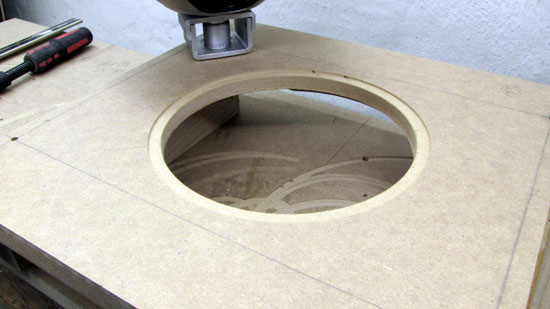 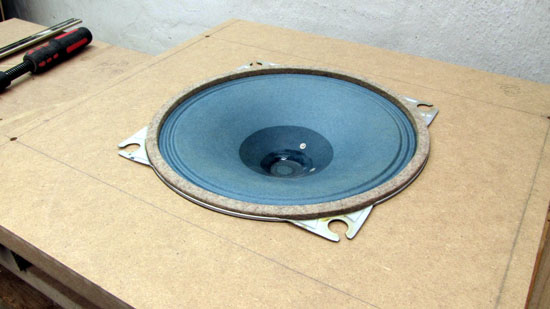
Routing for front mounting.
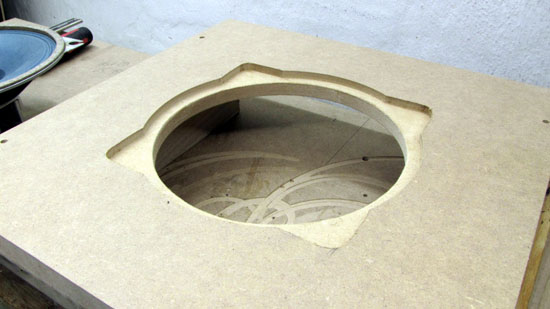 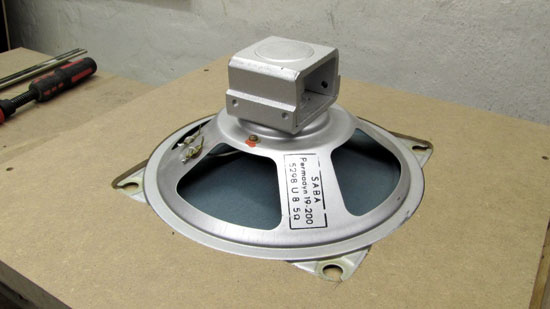
Routing for rear mounting, assumed 12 mm baffle.
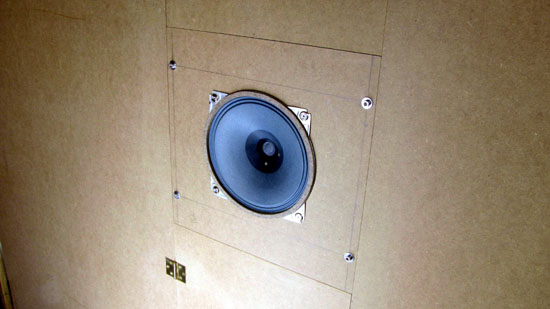 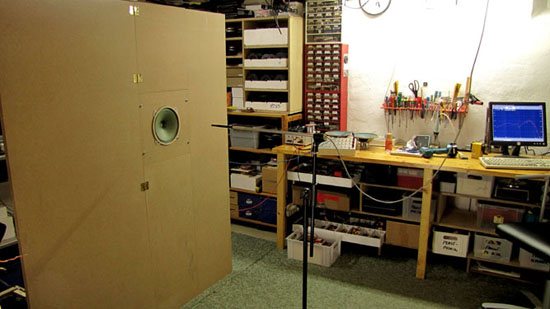
Measurements on IEC baffle.
Modelling example from web:
(back to
top)
http://www.lampizator.eu/SPEAKERS/PROJECTS/P17

Note bass with inverted polarity. Eminence Deltalite-II
2515 used here.
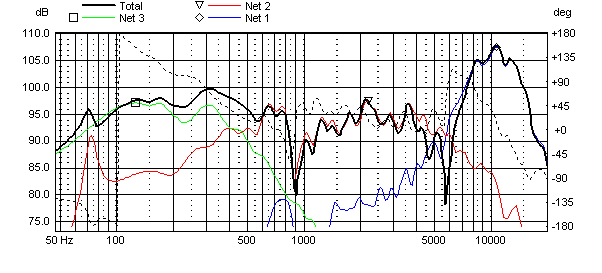
Modelled
frequency response with Eminence Deltalite II 2515.
Middriver added 12 mm baffle (dZ = -12 mm).
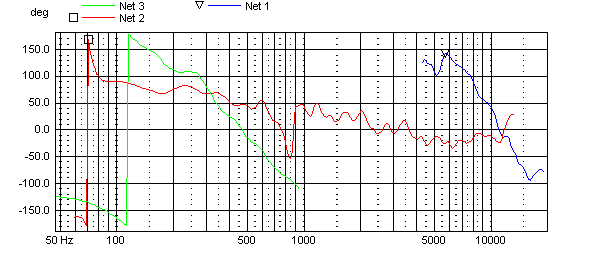
Modelled
phase tracking of drivers as suggested by constructor.
---o-o-o----
When we
use 1st order filters we usually have to invert driver
polarity and this is how it looks when
we connect bass and tweeter with positive polarity and
mid with inverted polarity:
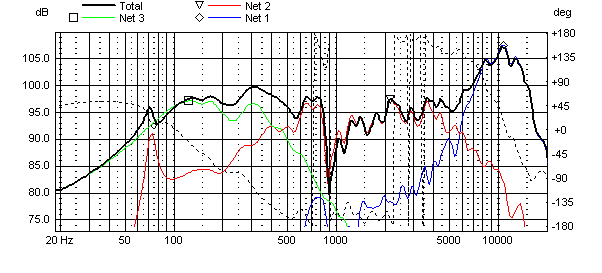
Apparently we get rid of the dip at ~6 kHz, but I wonder
how a 10 dB peak at 11 kHz really sounds.
This is a very broad peak ranging from ~6-14 kHz. Some
serious upper treble level.
----o-o-o-----
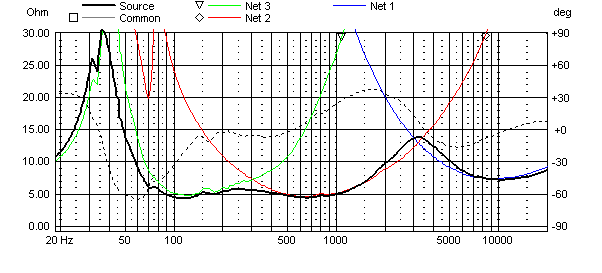
Modelled
impedance of system. 15" bass driver impedance from
open baffle (OB9).
Building a "resonanz"
box
(back to
top)
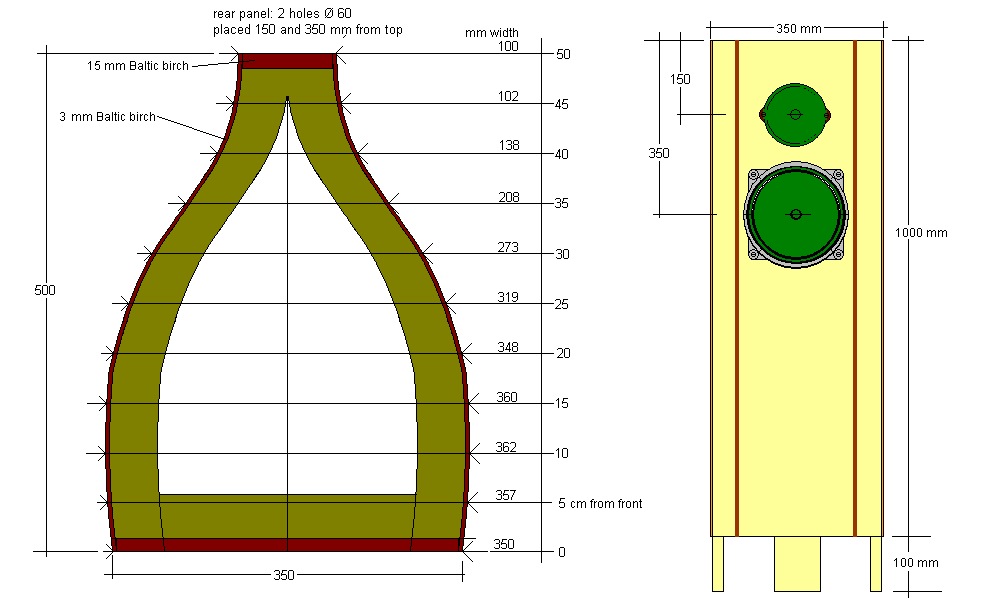
My
greencones cabs as they are likely to appear. 15 mm
Baltic birch for front, rear, top and bottom bracing. 3.8
mm BB for sides.
Building
the cabs
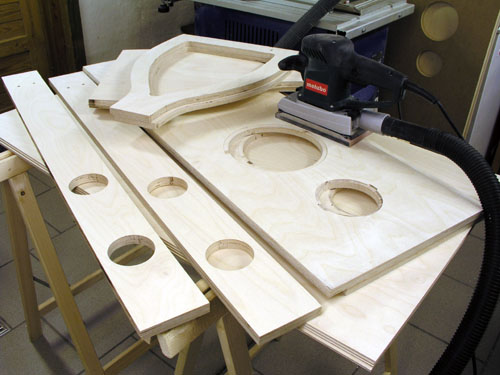 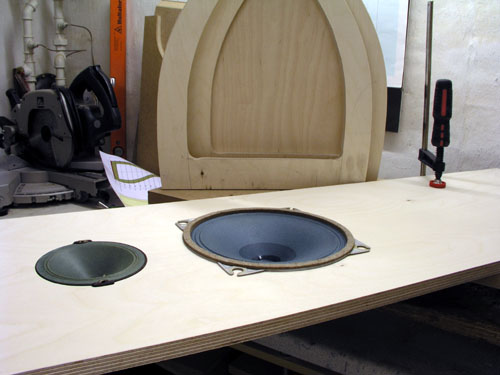
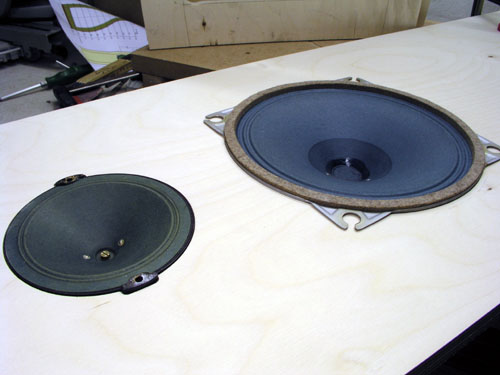 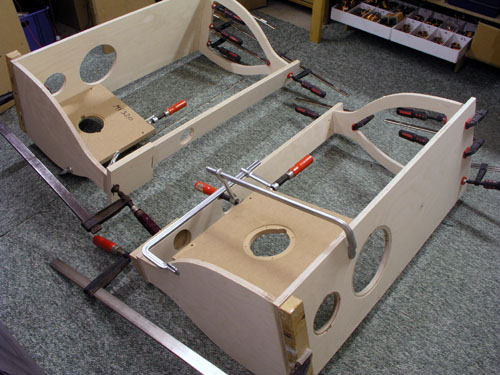
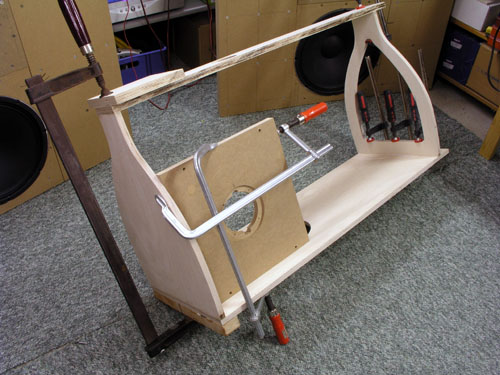 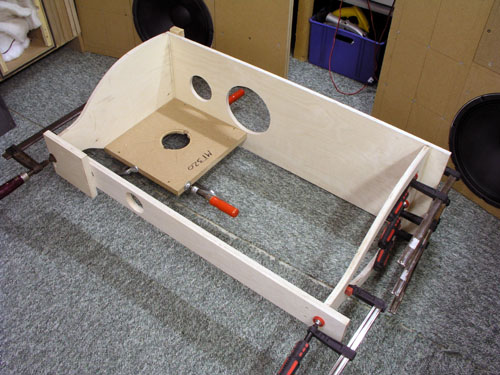
All of this is pretty straight forward. The difficult
part is bending the 3.8 mm side panels. Takes a lot of
clamps.
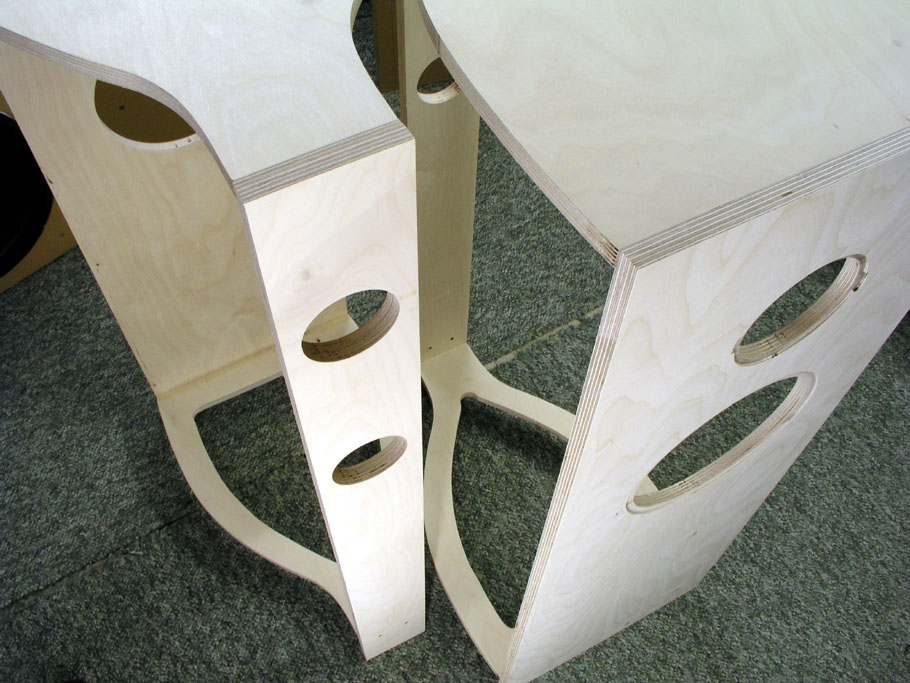
Measurements
from mounting drivers in resonanz boxen
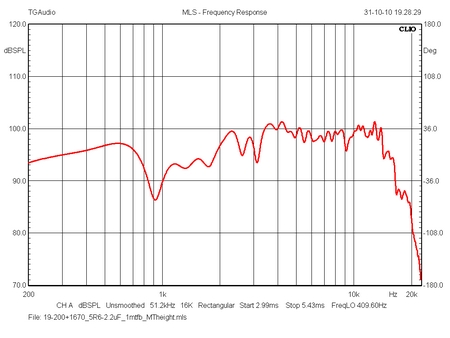 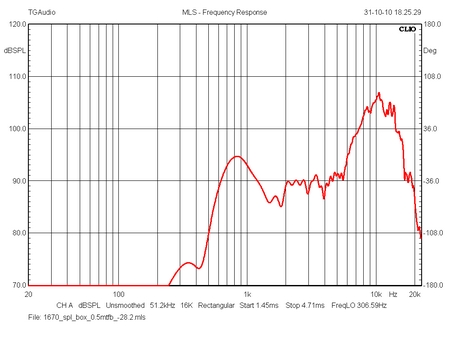
The basic measurements from midbass SABA PERMADYN
19-200-5298-U8 (left) and tweeter SABA 1670-DU-20
(right).
As predicted from measuring TS data, we're
in for a system making 94-95 dB/2.8 volts. The low-ohm
voice coil is partly responsible for this high
sensitivity. Except for the serious outphasing around 900
Hz the 8" greencone display a fairly linear
response. The 2-15 kHz range is some 5 dB above midrange
level and calls for equalisation unless we want a much
too elevated treble response - because this is going to
play treble. The greencone tweeter is very much a
pzzzztt-thing adding some airiness to the top octave.
What the tweeter does below 6 kHz is pretty much useless
and better be filtered out, not interfering with what the
8" driver covers. The useful tweeter level is also
some 10 dB above target system sensitivity and may
require quite some attenuation.
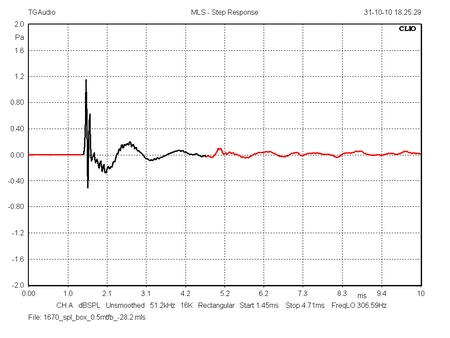 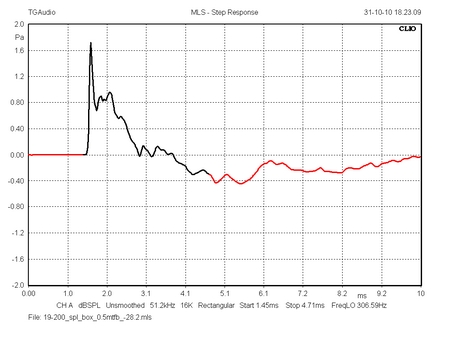
Before looking further into the possible
crossovers, let's take a look at drivers' step response.
To the left the tweeter where we have some serious
problems. Due to the cone being fastened to the center
pole piece we have a kind of mechanical high-pass filter.
After the initial positive peak we have a negative peak
indicating the cone moving inwards followed by a positive
response before settling. Where this happens is hard to
say, but using the tweeter only above 6-7 kHz may prove
beneficial.
The 19-200 driver to the right looks a bit better
although the 900 Hz cone break-up most likely is
responsible for the less than ideal decline. From a
modern perspective these drivers are not particularly
well designed.
The "web" crossover:
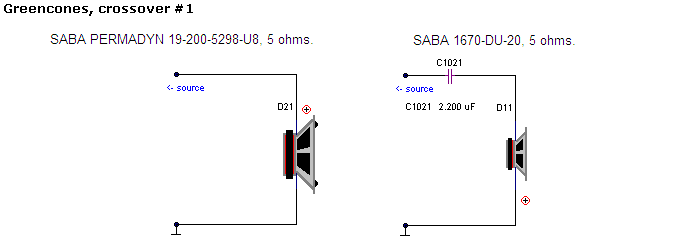
Single coil to the tweeter, that's all! The purist's
approach.
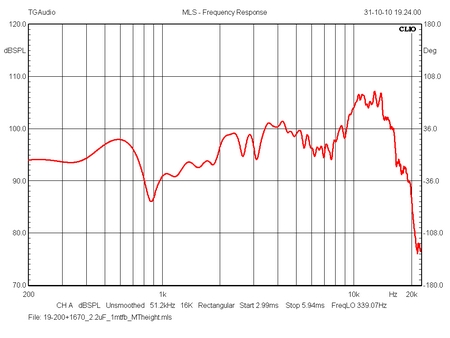 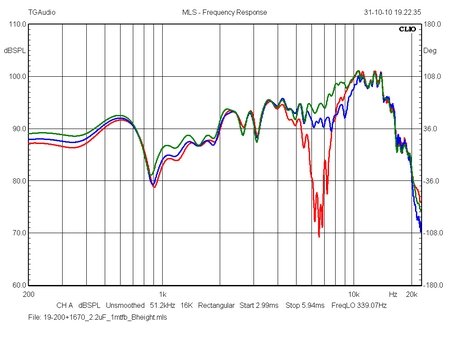
What's seen above is what can be found on
the web. No low-pass filter to the midbass and 2.2 uF to
the tweeter. Polarity of tweeter is dubious as wavelengh
is short at 7 kHz and whether tweeter should be connected
with poisitive or negative polarity doesn't make serious
impact on performance. Above to the right measurements at
T height (red), between M and T (blue) and at M height
(green). At T height we have some outphasing at 6.5 kHz
and as listening position is likely to at T height, it
may be advantageous to reverse tweeter polarity. From the
web it can also be found that a single cap to the tweeter
doesn't change the phase... Of coarse it changes the
fase.
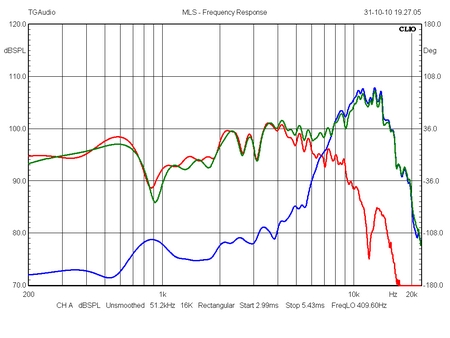 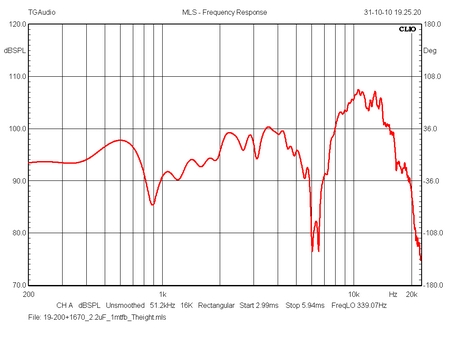
To the left the response of individual
drivers driven from crossover (red and blue) plus summed
response (green). Point of crossover around 6 kHz. To the
left we have the response @ 1 meter distance and at
tweeter height. Some outphasing is seen but having the
point of crossover this high, it's hard to hear
noticeable difference from positive or negative tweeter
polarity.
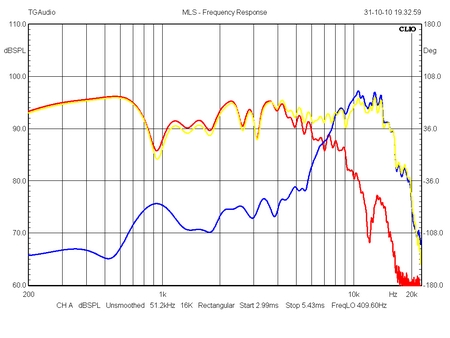 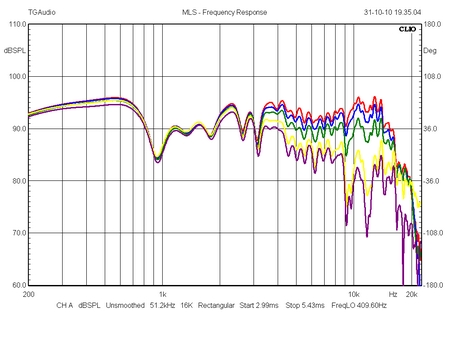
Left: Adding 15R to the tweeter helps a lot the harsh
upper treble is gone. Still, I'd like the tweeter's
response at 1 kHz further down.
Right: Again 15R to tweeter and horizontal dispersion at
0, 5, 10, 15 and 20 deg.
Despite having the midbass working up to 6 kHz we have a
decent dispersion up to 4-5 kHz. Not bad at all.
Not surprisingly, at 15 deg. off-axis the large cone
tweeter starts loosing grip.
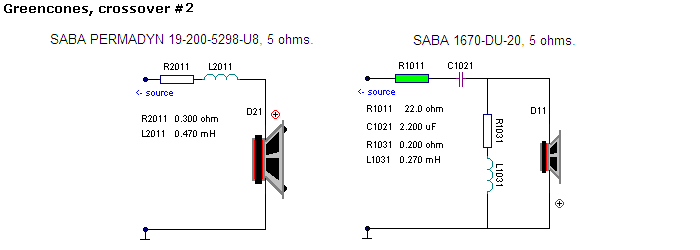
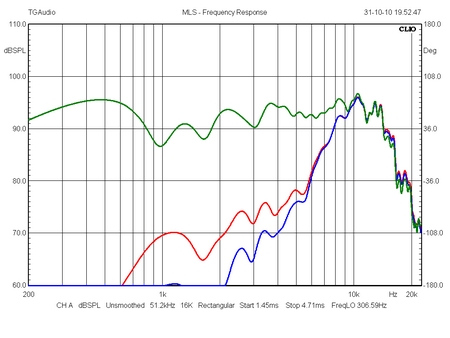 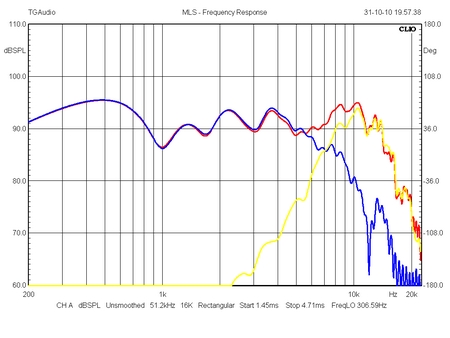
Left: Adding 0.27 mH to the tweeter section improves
sound considerably. Right: Individual and summed response
from #2 crossover.
R1011 increased from 15R to 22R.
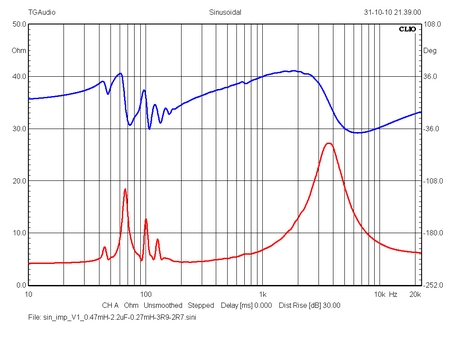 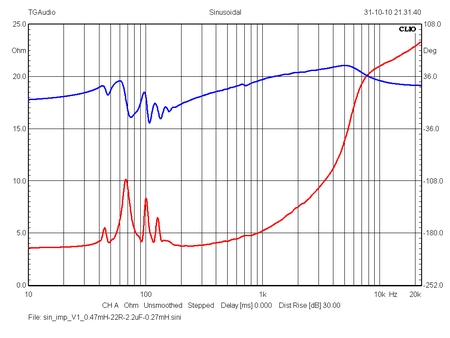
What's the impedance of a resonanz box
like?
Hmm... these cabs certainly are resonant! Multible peaks
in the 40-150 Hz range.
Left: Impedance from #3 crossover. Right: Impedance from
#2 crossover (22R to tweeter).
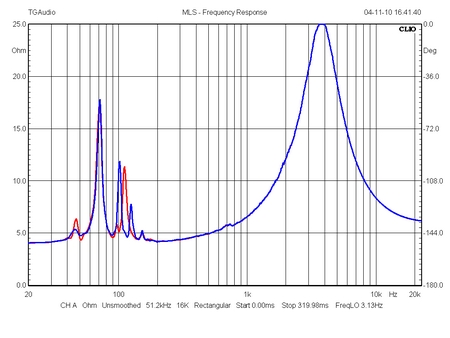 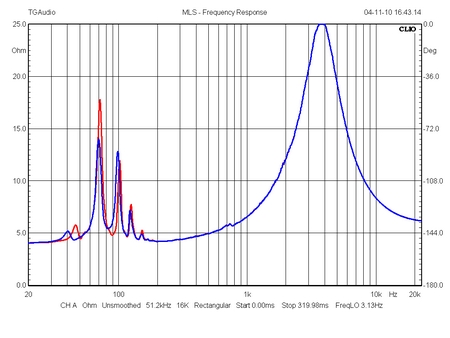
Left: What happens if we turn the speaker up-side down?
The 100Hz peak moves some 25 Hz up (red), so the the
length of the "tube" and distance to floor
impacts performance. Right: Here the two holes (vents) on
the narrow rear panel have been blocked and these play a
role too.
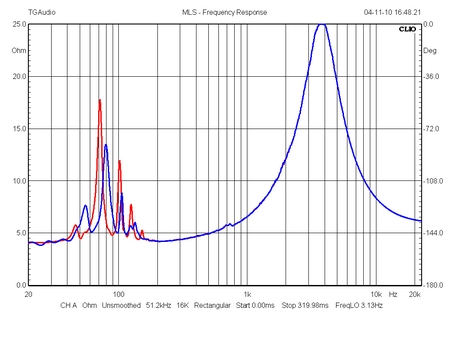
Final experiment. Sitting behind the speaker I pressed my
knees against the bent panels (blue) - and yes,
the resonance modes of the panels certainly have an
impact on impedance profile.
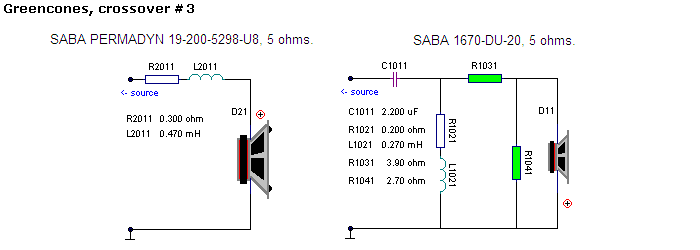
Replacing 22R tweeter series resistor with R1031 and
R1041 is just another way of doing the same thing. Makes
a nicer impedance plot.
10 dB attenuation: R1031 = 3R9, R1041 = 2R7
6 dB attenuation: R1031 = 3R3, R1041 = 6R8
3 dB attenuation: R1031 = 1R8, R1041 = 15R
The Greencone Resonanz Box Sound
Now, resonant boxes are
certainly something very different from conventional
speakers enclosures, where measures are taken to reduce
cabinet resonances as much as possible - or as much money
allows. It's not that difficult to find a
"resonanz" box in a supermarket
"hifi" section. "Cigar-box" speakers
have been available since separate speakers became
available.
First of all, the usual knuckle test leaves the
impression - or expectation - that this just won't work.
These cabs are boomy like crazy. I'm sure that if we used
a standard 8"/Fs=30 Hz woofer in these cabs they
would indeed be way too boomy. But a featherlight paper
cone driver, having Fs = 70 Hz is another story. Such a
driver won't play much bass in a standard cab anyway - at
least not below 70 Hz - despite low electrical damping.
But when what it does below 70 Hz makes close to one
square meter bent plywood panels resonate - then we have
bass. I was surprised to see an FFT plot suggesting bass
response down to 40 Hz despite a severe suck-out around
60-65 Hz. This suck-out appeared regardless of room
position and I'm afraid it has to do with the open bottom
leaving some 130 cm between the front and the rear of the
main driver. 1.3 meter is the wavelength of 344/1.3 = 264
Hz. The quarterwave is 66 Hz, halfwave is 132 Hz, which
fits nicely with the resonances seen from the impedance
plot. The 100 Hz peak may be due to a resonance between
top and floor - or the peaks may be derived from the
resonating plywood panels. Most likely it's a combination
of both. More measurements and tests are needed, and as
can be seen from above, damping the side panels seriously
alters the impedance profile.
What worries me the most is that once these panels have
been energized, they will inevitably return
stored/delayed energy to the drivers' cones and smear
detail and resolution. In fact, it sounds as this is
actually happening when we crank up the volume a bit. The
use of bent and light-weight side panels is one way to
control this phenomenon and what can also be seen is that
the peaks are very sharp, meaning the resonances die out
fast, and so they should. In fact, tuning a light-weight
paper cone to resonant wood panels may be just as
difficult as adding braces to a guitar deck, only here
have the energizer (strings) closely linked to the deck -
and what we want is sustrain, where the speaker uses air
to energize the panels and we want the panels to stop as
soon as the speaker cone stops. Air, as we know, is very
flexible (easy to compress) and may not be a good energy
transmitter here.
The bass response from
these greencones/resonanz boxes was better than
anticipated. Not boomy or blurred, but lightweight and
"short" like from a Voigt horn or similar.
Having an extended range driver doing most of it - here
up to 6-7 kHz - sounds like what it is, i.e. due to the
cone diameter, beaming starts around 2 kHz and having
most of the treble area beamed at you smears detail and
reduce perceived level of transparency. This phenomenon
has been experienced over and over again and it seems an
inevitable trade-off if we really do not want a point of
crossover in the 2-6 kHz range. One reason I would like
to hear the Altec 755A is due to the cone shape, having a
fairly large "domed" voice coil and rather flat
cone geometry. This may render beaming less apparent -
but some other time should someone ever pop in with a 755
for test.
The "web-crossover", 2.2 uF to the tweeter with
no attenuation, is really bad. The upper treble is harsh
and forward and well, just too much. Adding the high-pass
filter to the 4" cone tweeter makes it do what it's
best at: Adding some airiness to the overall
presentation. This tweeter, due to its fixed cone, really
shouldn't do anything in the 1-6 kHz range. The tweeter
diameter will make beaming apparent already at 3-4 kHz
and had we started from a blank piece of paper, we would
not even consider a large cone like this. A small
three-quarter-to-one inch "something" would do
much better in the 6-20 kHz range, but this is greencone
territory and green it must be.
What surprised me even
more was that my 300B amps didn't feel too comfortable
with these speakers. I was sure this would be an ideal
match, but it wasn't. Comparatively my 300B amp is doing
better with my coming OB-11 open panels (15" bass
driver + JA8008/TW034). My 20 wpc PSE Audio Mirror amps
had no trouble running the greencones, so I wonder if
this is really the ideal speakers for "low-wattage 2
wpc DHT SE amps".
To conclude my
greencone/resonanz box experiences: These thin-paper
greencones have limited soundstage capability and soon
start generating serious distortion. Play music with low
content of deep bass and they provide an excellent
midrange for e.g. the oboe and flute and can be enjoyed
free of any point of crossover in the mid and lower
treble range. Using the drivers as an extended range
driver up to 6 kHz calls for limitations too. Beaming -
the enevitable result of having a large diameter speaker
doing treble - limits sense of depth of soundstage and
treble quality - as such - is not always good if the
driver handles bass notes at the same time.
The basic learning I take from these experiments is that
a resonant box can make bass - and decent bass too - if
not pushed too hard - and finetuning the panels to the
actual driver may be an endless occupation.
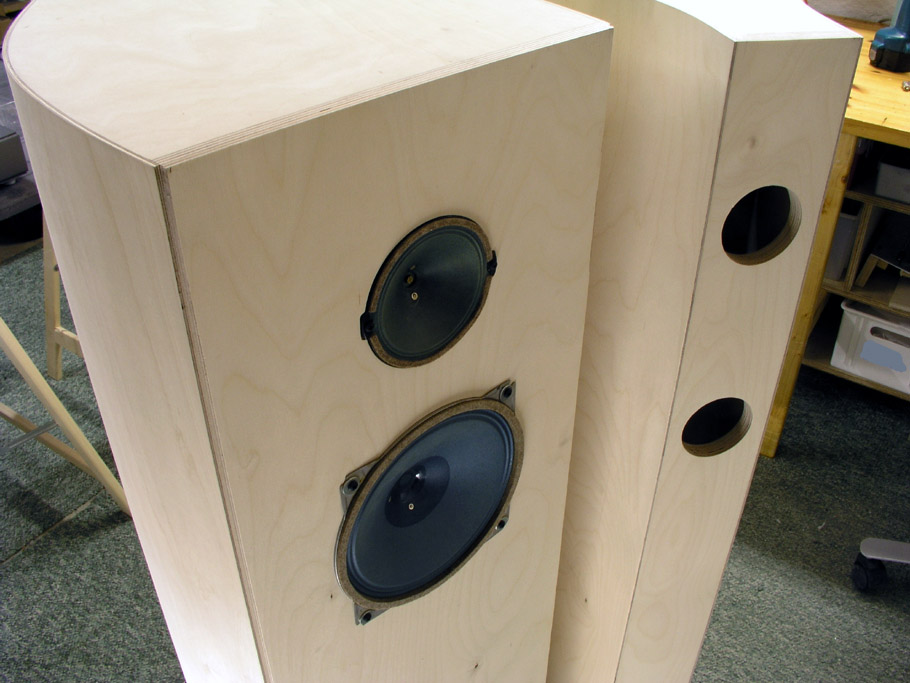
Believe me: Bending/gluing the side panels was much more trouble than anticipated.
Aftermath
This story turned out to
be not quite as closed as planned. Having a spare pair of
19-200 greencones for experimentation I mounted these in
the resonanz cabs and I was in for surprise.
These spare 19-200 drivers have had the dust cap removed
and the corrugated paper surrounds were treated with a
thin flexible coating. As discussed previously, the
rugget dust cap forms a cavity to the center pole piece
and having a very narrow magnetic gap, the trapped air in
this cavity forms a pneumatic brake helping keeping
things in place during large cone excursions. Check
impedance measurements above. Coating the
surround also makes a smoother frequency
response in upper mid/lower treble.
Setting up the speakers
with my 300B amp now made a much more full-bodied sound
with excellent bass, smoother midrange and the drivers
could now handle much higher sound levels with no
apparent distortion. I assume the bigger amps are less
susceptible to this problem as they simply have better
control (damping factor). The 300B really can't manage
this problem with its limited 8 wpc. Smoothing the 10 dB
dip at 900-1000 Hz certainly improved the overall
presentation of acoustic instruments and making an
in-room FFT plot now revealed a smooth bass performance
down to ~45 Hz with no suck-out in the 60 Hz range as
seen previously.
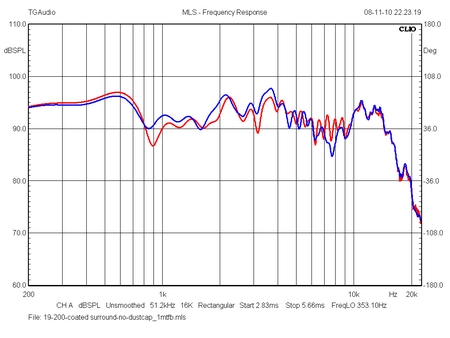 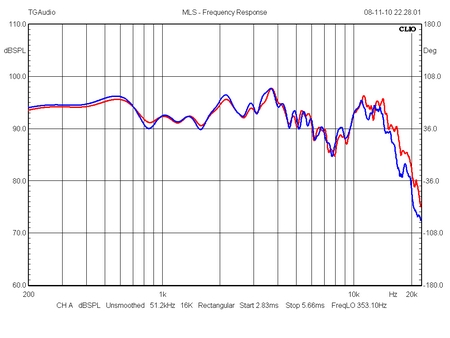
Left: Red = 19-200 driver as-is. Blue: Coated surround
and dust cap removed.
Right: The two resonanz boxes at 1 m/2.8V. Disregard dip
at 8 kHz. Very much depends on microphone placement.
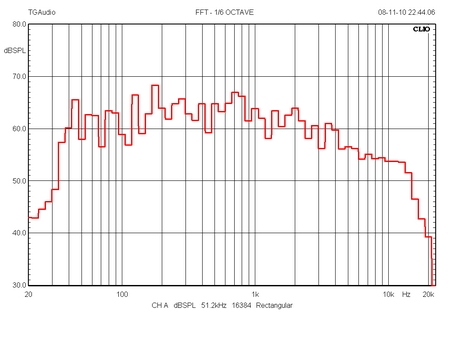 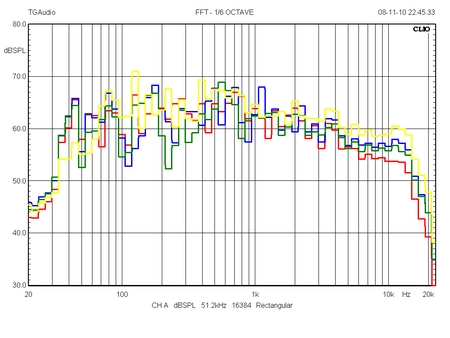
Left: 1/6 octave FFT displaying adeaquate response down
to 40-45 Hz. Right: Moving the microphone around my
workshop makes these graphs.
The treble decline is normal behaviour for FFT farfield
measurements.
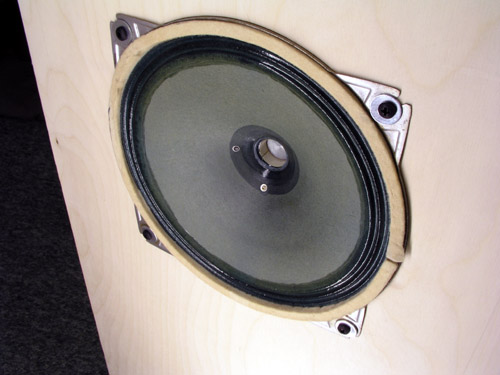 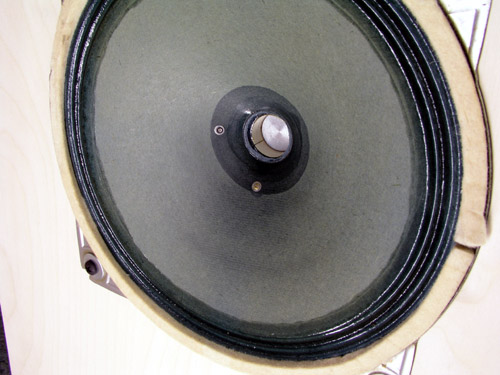
The modded 19-200 drivers.
Sorry for the colour tone. They're green.
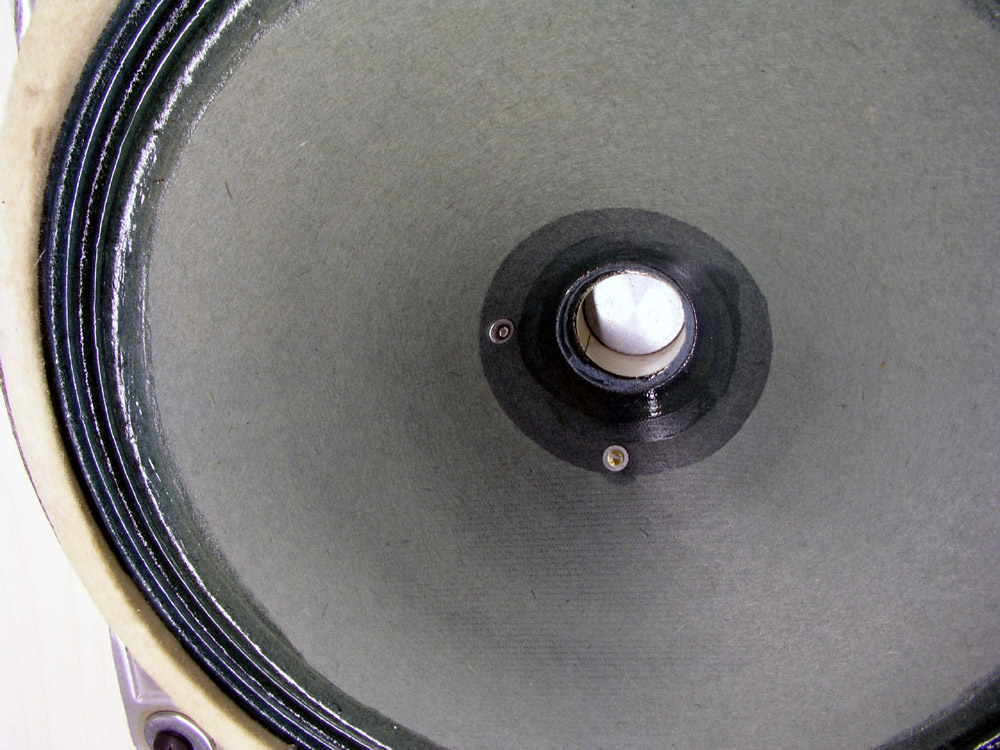
The cure: Cut off the dust
cap with a scalpel. Coat the surround twice with thinned
book binders' glue.
Please find out for yourself the brand of glue and how
much dilution it needs. The final coating should be
slightly sticky without attracting dust.
Glue used for vinyle tiles may be another option. This
needs dilution too. Make test coatings with various
degree of dilution on cardboard.
--o-o-o--
Before resonanz boxen is finnally closed
an article on "blackcones" will be publised.
This from vintage SEAS 21TV-G midbass and SEAS 9TV-LG
tweeters.
|
 Greencone
Sound
Greencone
Sound























































